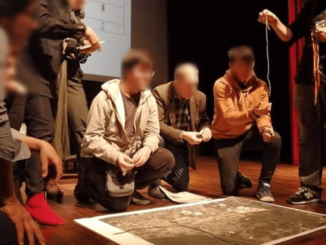
Using game methods to translate city plans into actionable steps for citizens.
In our globalized and urban world, cities have a unique role and responsibility to ensure that people and nature alike can thrive.
However, when thinking about this monumental undertaking, we turn to city governments to develop and execute a vision of the future. As cities take cautious steps to launch their post-covid economic recovery plans, securing community engagement will be critical to achieving important global targets set out by the SDGs and the Paris Agreement. Applying game-design elements to real-world scenarios can increase community engagement by responding to some of our most basic social instincts, including our search for purposeful work and our need to create strong social bonds.
Cities matter a lot. Here’s why
Home to 55% of the world’s population — cities account for over 60% of global energy use and more than 70% of global greenhouse gas emissions. At the same time, there are vast inequalities in city residents’ experience of urban life, ranging from health, housing, and political representation to access to essential services, employment, and wider opportunities. COVID-19 recovery efforts are a chance to reinvent city infrastructure and incentives to create better lives for everyone in the context of increasingly complex global issues.
Getting our cities into the safe and just space of the Doughnut
C40’s Thriving Cities initiative is being piloted in Amsterdam, Portland, and Philadelphia to help transform cities’ economies into thriving systems. Their point of departure is Kate Raworth’s theory of Doughnut Economics. In short, the Doughnut’s social foundation sets out the minimum standard of living to which every human being has a claim based on the UN’s sustainable development goals.
Doughnut Economics: Seven Ways to Think Like a 21st-Century Economist is available from Amazon

The Doughnut’s ecological ceiling identifies Earth’s critical life-supporting systems and the pressure limits they can safely endure based on Rockstrom’s 9 planetary boundaries. Between the social foundation and the ecological ceiling lies a doughnut-shaped space in which it is possible to meet the needs of all people within the means of the living planet — an ecologically safe and socially just space in which humanity can thrive.
The Amsterdam city government is a good example of how these insights are being applied. They launched Structural Vision Amsterdam 2040 in 2014, putting economic stability and resilience at the heart of their economic recovery plan. They’ve identified 9 ways to turn the Doughnut economics framework into transformative action. A few of these are strategically important:
- Vision: Create a compelling vision of what it means to become a thriving city.
- Mobilize: bring together the city stakeholders needed to bring about change.
- Mindset: Embrace the values, ways of working, and new narratives needed to bring about change.
The first barrier to citizen engagement many municipalities face is translating their vision into a clear goal and actionable steps that people can engage with. The second one is how to mobilize stakeholder’s towards achieving a common goal. Lastly, incentivizing people to adopt a certain mindset and values is not easy when people are constantly exposed to pervasive environmental primes. Understanding how people react to their environment is the first step towards solving these three issues.
People are at the center of urban life

Residents are the dynamic and creative heartbeat of any urban center in the world. It isn’t enough to create regenerative and fair economies to develop a series of policies and trillion-euro budgets to overhaul current infrastructure flaws. City planners need to understand what makes a city tick. This means intimately understanding how the built environment permeates and shapes human experience.
Architecture critic Sara Goldhagen explains that our built environment experience results from what behavioral economists call primes.
A prime is a nonconsciously perceived environmental stimulus that can influence a person’s thoughts, feelings, and actions by activating memories, emotions, and other cognitive associations. — Goldhagen, Welcome to Your World.
In short, a prime refers to the influencing of thought or action by a physical object in our environment.
For example, a famous experiment led by Kathleen Vohs in 2006 tested how a group of students would react to collaborative problem-solving scenarios when shown money-related primes. The first group of students was placed in a room with a stack of monopoly money. As a result, relative to non-primed participants primed, group 1 preferred to play alone, work alone, and put more physical distance between themselves and a new acquaintance.
Take a moment to let that sink in. Money-related objects prime individualistic behaviors. Upscale that to the city level, and think about the effects of seeing an atm every two blocks. Our entire urban infrastructure is designed to prime individualistic behaviors.
How can we create equitable and resilient cities when our entire urban framework motivates us to go in the oppostive direction?
Gamifying social action towards thriving cities

Games are the quintessential autotelic activity, we only ever play because we want to. Understanding how games can prime social, collaborative action can help us develop strategies that make the most of community action in post-covid economic recoveries. Drawing from revolutionary game designer Jane McGonigal’s insights, here are a few ways in which games can harness community engagement towards social change:
Turning urban visions into clear goals and actionable steps
Having a clear goal motivates us to act: we know what we’re supposed to do. But the language used in urban planning alienates the average person. The vision outlined by municipal planners lacks clarity in lay terms, and the actionable items are usually reserved for an elite group of technocrats in charge of leading the implementation process. On the other hand, games outline a clear goal that players work to achieve and layout actionable next steps towards achieving this goal. Gamifying Amsterdam’s structural vision 2040 would turn its goal of achieving an economically stable and resilient recovery into clear goals and actionable steps that people can engage with on their own time to win the game. Equally important, devising an immediate feedback system would keep people engaged by seeing how their actions translate into results in real-time. A simple app or leader board could be enough to activate engagement.
Mobilize
We are social animals before we are economic ones. We crave strong social bonds and active connections with people we care about. But bringing stakeholders together to achieve a common goal is hard when money primers in our urban setting encourage isolation. Games create an immediate sense of community by creating a shared game reality. Players recognize each other because they have a common understanding of what they’re doing and why. Furthermore, the more time we spend interacting within a social game space, the more likely we will generate prosocial emotions like compassion, pride, and complicity that are critical for activating collaborative action. Gamifying Amsterdam’s structural vision would require creating a simple digital community platform to host these engagements, allowing people to seek opportunities to engage and collaborate in the real world. They could also pinpoint key game spaces throughout the city where people can interact with their gamer community outside the digital space.
Mindset
Norms and behaviors are generated during early childhood years and become instincitve later in life. One of the most difficult things to achieve is to re-pattern thoughts and behaviors. According to behavioral economist Daniel Kahneman, 95% of the time, we are intuitive decision-makers. This means that we make decisions based on automatic cognitive associations that become mental shortcuts in our daily lives. The less we have to think about our actions, the better, according to our brain’s hippocampus. This is bad news for policymakers seeking to communicate the importance of sustainable behaviors through traditional educations tools. Education tools like curriculums activate effortful thinking, which we only really use 5% of the time when writing articles like this one or attempting to solve complicated math problems like the one below:
57 x 124
Attempting to communicating the complexities of climate change through education curriculums will always fail to achieve behavior change. It’s simply activating the wrong part of our brains. Instead, games activate system 1 intuitive thinking. By staying in the realm of intuition, players exit current behavioral paradigms and are open to engaging with different behaviors that will enable them to win the game. If the game rewards collaborative action, players will be intrinsically motivated to act collaboratively. Gamifying Amsterdam’s structural vision would take community stakeholders out of the boardroom and into the game space, where their effortful cognition is less likely to kick in in pervasive ways.
Final Thoughts
If cities stand a chance of attaining the goals outlined in their economic recovery plans, they need to transform the city into a game that everyone can play. A few key ways to do this include:
- Transforming structural visions into actionable steps. Games can turn unclear structural visions into clear goals with actionable items. They can also help people engage with the key milestones by giving them a feedback system to track their progress.
- Creating a gaming community. Increasing a sense of collective action by creating a game space and mission that everyone understands and feels involved in.
- Activating collaborative mindsets. Games are great behavioral primers because they rely on intuitive thinking processes rather than effortful cognition. A well-designed game can prime collaborative and regenerative behaviors by creating rewards and winning strategies that incentivize them.
Lastly, a well-designed game has an immersive game space. Luckily, cities are exactly this. Policymakers can contribute to changing the game’s rules by thinking about which behaviors their city is currently rewarding and designing creative ways to streamline the behaviors that would exist in the thriving city of the future.
- Gamifying Social Action Towards Thriving Cities. - 12th November 2021





The first picture looks like the city centre of Seoul.
It is! I remember using this image in a sustainability course I designed, to show an example of a re-greening project.